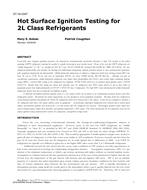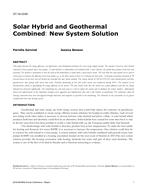-
-
Available Formats
- Options
- Availability
- Priced From ( in USD )
-
Available Formats
-
- Immediate download
- $16.00
- Add to Cart
Customers Who Bought This Also Bought
-

ST-16-C034 -- GreenHP: Design and Performance of the Next...
Priced From $16.00 -

ST-16-C067 -- Hot-Surface Ignition Testing for 2L Class R...
Priced From $16.00 -

ST-16-C059 -- Solar Hybrid and Geothermal Combined: New S...
Priced From $16.00 -

ST-16-C010 -- Analysis of Radiant Cooling System Configur...
Priced From $16.00
About This Item
Full Description
In Canada, outside air temperatures vary significantly throughout the year. A temperature gradient of 70 °C (126 °F) between the cooling and heating season is common in many Canadian regions. Due to the high thermal inertia of the soil below the frost line, ventilation air supplied through earth tubes will benefit from a significant temperature increase or decrease with respect to heating or cooling season. The advantages of an earth-to-air heat exchange system include its simplicity, high air pre-cooling and pre-heating potential, resultant fossil fuel savings and related greenhouse gas emissions and lower operations and maintenance costs. Very few experimental studies of the earth temperature impact with earth-to-air heat exchanger were found in the literature for cold climates. Therefore, this paper evaluates the performance of an earth-to-air heat exchange system for an operational Canadian building; with the aim of characterizing its efficiency. The building; Earth Rangers in Woodbridge Ontario, is a multi-purpose centre built to educate mainly children with respect to biodiversity, conservation and the adoption of more sustainable living behaviour. The earth tube system is an earth-to-air heat exchanger system which consists of nine 900 mm (35.4 in) diameter, 20 m (65.6 ft) long pre-cast concrete pipes buried beneath the frost line (approximately 1500 mm (5 ft) below grade). Outside air is drawn through the buried concrete pipes allowing surrounding earth to moderate the temperature of the incoming air such that it is either pre-heated or pre-cooled depending on the time of year. The performance assessment of the earth tube system consisted of continuous field monitoring for the period of January through November 2014, which encompasses both the winter and summer season. Results from the field monitoring are presented in terms of (1) overall heat exchanger effectiveness and (2) comparing the pre-heating effectiveness of the monitored earth tubes and exploring what could be done to improve the design. This earth tube field study has confirmed the overall positive winter and summer effectiveness of this passive design measure.





